
Reference Publication: Khattar, M K, M V Swami, and N Ramanan, "Another Aspect of Duty Cycling: Effects on Indoor Humidity." FSEC-PF-118-87, Florida Solar Energy Center, Cape Canaveral, FL 32920. ASHRAE Transactions, January 1987. Disclaimer: The views and opinions expressed in this article are solely those of the authors and are not intended to represent the views and opinions of the Florida Solar Energy Center. |
Another Aspect of Duty Cycling:
Effects on Indoor Humidity
M. K. Khattar,
M. V. Swami, and N. Ramanan
Florida
Solar Energy Center (FSEC)
FSEC-PF-118-87
Abstract
The effects of two readily available air-conditioner control strategies on dehumidification performance are discussed: fan "auto," in which the indoor air circulation fan cycles on and off along with the compressor, and fan "on," in which the fan operates continuously regardless of the on or off status of the compressor. Measured performance data are presented on two air-conditioning systems - a packaged terminal direct expansion, constant volume air conditioner without capacity modulation and a unitary direct expansion air conditioner with dual-speed compressor and indoor air fan motors. Measurements of the condensate removal from the air conditioner as well as its transient sensible and latent cooling performance tuning cycling operation showed that the net moisture removal was reduced significantly when the fan operated continuously compared to when the fan cycled off with compressor. The average moisture-removal performance was relatively independent of the compressor run-time fraction in the fan "auto" mode, but it varied significantly in the fan "on" mode. The air-side transient performance measurements for the packaged terminal air conditioner showed that in a 20-minutes air-conditioning cycle - with the compressor on for 10 minutes and the fan operating continuously for the remaining 10 minutes - 19% of the moisture condensed turning the compressor "on" cycle was re-evaporated back into the conditioned space. In another 10-minute cycle with only 5 minutes of compressor run time, condensate-side measurements showed that the moisture removal rate was reduced by 44% in fan "on" mode, compared to the fan "auto" mode.
The re-evaporation rate increased with increased number of cycles.
The indoor humidity level was higher in fan "on" mode compared
to the fan "auto" mode. It can be concluded that most air-conditioner
duty-cycling devices, which let the indoor air fan operate after the
compressor turns off, will re-evaporate some of the condensed moisture
on the cooling coil and in the drain pan back to the conditioned space.
Such devices will result in increased indoor humidity level and associated
discomfort.
Introduction
Several air-conditioned duty-cycling devices have appeared in the market that claim to reduce energy consumption. Most of these devices purport to use stored cooling in the cooling coil of an air conditioner. Generally, these devices let the indoor air fan continue to operate while forcing the compressor to cycle on and off with certain predetermined or even self-adjusting schedules. The argument used to support this approach is that once the cooling coil is cold, the compressor may be shut off, and the stored cooling due to thermal mass of the cooling coil may be recovered by letting the indoor air fan operate. This approach, of course, fails to account for the fact that energy would be consumed in cooling the thermal mass of the cooling coil after the re-start of the compressor. On an overall thermodynamic point of view, this approach does not seem to provide any energy benefit. On a micro-level, however, there may be some gains in the efficiency of the vapor compression cycle due to the resultant increase in the average cooling coil operating temperature.
On a typical residential air-conditioner thermostat, two modes of operation are readily available. In "auto" mode, the indoor air fan cycles on and off along with the compressor on demand from the thermostat for cooling. In the fan "on" mode, the indoor air fan operates continuously, while the compressor cycles on and off on demand from the thermostat.
The air conditioner's "auto" and "on" operating strategies maybe considered as two extreme forms of duty cycling as far as their effect on moisture removal is concerned. The fan "auto" represents no duty cycling, and fan "on" may represent a duty cycling mode in which the indoor air fan never stops. In some duty-cycling devices, the fan may be allowed to operate for only a certain period after the compressor turns off.
Although there are several advantages and disadvantages of operating an air conditioner in "auto" or "on" modes, some of which are summarized here, special attention is devoted to the moisture removal, or dehumidification, aspects of the air conditioner's performance. The advantages and disadvantages of duty cycling devices may be in between the two modes of operation.
Advantages and Disadvantage
- In the fan "on" mode, air movement is maintained
even after the compressor stops. This provides some degree
of comfort, although very small. However, due to no air movement
in the fan "auto" mode, pockets of warm air may develop.
The thermostat may also sense false temperatures due to the
pockets of warm air.
- The fan motor consumes significant energy for air movement, typically
raising the moving air temperature by 2 F. Not only does it adds
heat to the space, but the air conditioner must run longer to remove
the added heat when the compressor turns on.
- When the compressor is on, moisture is condensed over the cooling
coil and collects in a drain pan. In the fan "on" mode,
when the compressor turns off, some of the moisture remaining on
the cooling coil and in the drain pan re-evaporates back into the
space, which increases the indoor humidity. In addition, fluctuations
in indoor humidity have been observed.
- The re-evaporation of water in the fan "on" mode provides
certain cooling in a manner similar to that in swamp coolers. Of
course, any cooling is obtained at the cost of increased humidity.
- In the fan "on" mode, certain cooling is available after
the compressor turns off due to thermal inertia of the cooling coil.
However, when the compressor turns on again, it has to work extra
to bring the cooling coil back to the lower temperature.
- In the fan "auto" mode, the condensed moisture drains
out. How well it drains out depends upon cooling coil and pan design.
- In the fan "auto" mode, it is easier to maintain indoor
humidity because the condensed moisture does not re-evaporate back
into the space.
- The compressor cycling rate will strongly influence moisture removal
in the fan "on" mode. An oversized unit, where the compressor
rung for a short time and turns off, can adversely affect moisture
removal and exacerbate the humidity problem. Air conditioners are
usually sized for peak loads with safety margins and, in effect,
are oversized for most operating hours.
- In the fan "auto" mode, moisture is not re-evaporated
into the space, and an oversized unit will not exacerbate humidity
problem.
- A higher indoor humidity level in the fan "on" mode may
prompt lower temperature settings, just to get rid of the extra moisture.
This will result in increased energy consumption.
- In the fan "auto" mode, air infiltration induced by the
indoor air fan is also reduced.
- The psychological effects of turning off the fan along with the compressor should be considered. Once people are used to fan noise, for example in office buildings, a sudden change to quiet and back to noise may be disturbing.
System Setup and Measurements
Performance data from air-conditioning systems of two buildings at the Florida Solar Energy Center were obtained. One building (PV House) is a typical 1,300 ft2 manufactured frame house with packaged terminal air conditioner. The house was used as office space during office hours. Its air conditioner was set to operate 24 hour a day during the test period. The other building (office) is a 1,580 ft2 trailer-type office building with two-speed unitary air conditioner. This system, however, is set to operate only during the office hours. The relevant air-conditioner design parameters are given in Table 1.
Table 1. Air conditioner design parameters at ARI rating
conditions
(Indoor: 80 F dry-bulb, 67 F wet-bulb; Outdoor: 95 F dry-bulb)
Description |
Total Capacity |
EER |
SHR |
Comments |
| 1. PV House | 29,600 |
8.40 |
0.78 |
Single-speed capillary tube expansion device |
| 2. Office | 35,800 |
11.85 |
0.767 |
High-speed comp/indoor fan |
20,200 |
11.85 |
0.777 |
Low-speed comp/indoor fan thermostatic expansion valve |
The PV house air conditioner is a single zone, constant volume, direct expansion system that is controlled by a single-stage thermostat. The office air conditioner is also a single zone, direct expansion system, but can operate at two compressor speeds, corresponding to two indoor airflow rates. It is also controlled by a single, but two-stage, thermostat. Since the air conditioner can drop to lower speeds at low loads, the air conditioner's compressor ran almost continuously throughout the experiments.
Two levels of instrumentation were used. One level of instrumentation was designed to obtain long-term performance data of the system under two modes of operation. The instrumentation consisted of a compressor-run time clock, an energy meter, indoor and outdoor dry-bulb/wet-bulb psychrometer, and a condensate gauge. A tipping bucket rain gauge with an electro-mechanical counter was calibrated and used as a condensate gauge. It was located below the air conditioner's condensate discharge pipe and provided a measurement resolution of 1/100 of a pound of condensed water. The air conditioner was operated at one temperature setting with fan "auto" for one week. During the next week, the fan switch was set to "on" without disturbing the temperature set point. The experiments were repeated at the same temperature set point, as well as at other set points, from May to September l983. The indoor and outdoor temperature and relative humidity were measured frequently with a hand-held dry-bulb/wet-bulb psychrometer. At the same time the cumulative amount of energy used, compressor run time, and amount of condensate collected were recorded.
For measuring air-side transient response of the air conditioner during cyclic operation, return and supply air dry-bulb/wet-bulb temperatures were scanned and reported every 10 seconds. The dry-bulb/wet-bulb temperatures were measured with an aspirated psychrometer consisting of two thermocouple tips, one bare and the other covered with a wet cotton wick soaked in water. Air was drawn over the thermocouple wires with a small blower.
The relative response time between the dry-bulb and wet-bulb thermocouples was measured. The aspirated dry-bulb/wet-bulb sensor was placed in an airstream and allowed to reach steady-state value. A resistance heater upstream of the sensor vas turned on. It increased the sensible temperature but did not change the air dew point temperature. The data were scanned every 10 seconds. At each 10-second time interval, the air dew-point temperature was calculated from the current dry-bulb reading, but previous wet-bulb temperature readings were used to account for slow response of the wet-bulb sensor. The lag time interval for wet-bulb data was varied from 0 to 40 seconds in steps of 10 seconds. The time lag of 10 seconds provided the best results in calculating dew-point temperature. The experiment was repeated with a data scan rate of 3 seconds and time lags of 3, 6, 9, 12, 15, and 18 seconds. The time lag of 9 seconds provided the best fit for calculating dew-point temperature. Therefore, the time lag of 10 seconds for wet-bulb temperature measurements was used in calculating the psychometric properties of cooled and dehumidified air in cyclic mode.
The condensate was measured with a tipping bucket rain gauge. The condensate cannot be measured instantaneously. It collects on the coil surface and runs down into the drain pan, which overflows into the rain gauge. There is a time lag between moisture condensation on the coil surface and its measurement by the rain gauge. In long-term measurements, this delay is not significant. In transient measurements during cycling, however, it cannot be neglected. Therefore, to compare fan "on" and "auto" modes, the air conditioner was operated continuously until steady flow of condensate was obtained before starting the cyclic tests. No attempt was made to maintain any specified indoor condition during cyclic measurements, but the cyclic tests under two modes were carried out in mostly identical indoor and outdoor conditions.
Results and DiscussionThe moisture removal rate versus compressor run-time fraction in each of the two operating modes in the PV house is plotted in Figure 1. This data is also summarized in Table 2.
Table 2. Summary of moisture removal data.
Indoor Temperature |
Fan "Auto" Mode |
Fan "On" Mode |
||||
oF |
Average Indoor Humidity1 |
Compressor |
Moisture |
Average Indoor Humidity1 |
Compressor |
Moisture |
80 77 76 71 |
55 60 67 74 |
.27 .35 .60 .80 |
1.65 1.64 1.65 1.72 |
65 70 70 75 |
.25 .34 .60 .80 |
.62 .87 1.34 1.72 |
Comments: The air conditioner operated alternatively for at least one week in each of the two modes: fan "auto" (fan cycles with compressor) and fan "on" (fan operating continuously regardless of compressor turning on or off). Normal office use, and direct control of internal loads or load pattern.
2 Compressor Run-time Fraction = Accumulated compressor run-time hours divided by the total hours during test period.
3 Moisture Removal Rate = Condensed moisture colleted below drain divided by the total kWh energy used by the condensing unit and the indoor fan. Indoor air fan motor is rated for 3.4 full load amperes versus 15.6 for the condensing unit.
The moisture removal rate is shown in pounds for each kWh of energy used by the air conditioner's indoor fan and compressor. The compressor run-time fraction is defined as the fraction of the total number of hours during which the compressor operated. It is proportional to the load factor, or the ratio of the cooling load to the air conditioner capacity. At a fraction of about 25% compressor run-time, the air conditioner in fan "auto" mode removed more than 2.5 times the moisture it removed in fan "on" mode. The fan "on" mode degraded the moisture removal rate by over 60%. It also increased the resulting indoor humidity from 55% to 65% However, at higher compressor run-time fractions, the moisture removal in the fan "on" mode improved. At 50% compressor run-time fraction, for example, the moisture removal at fan "on" was about 30% lower than in fan "auto." At 80% compressor run-time fraction, however, the moisture removal rate in fan "on" and fan "auto" as well as the indoor conditions were nearly the same.
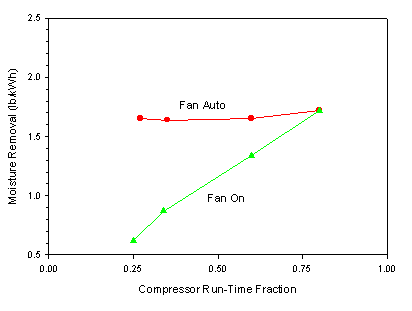
Figure 1. Moisture removal vs. air-conditioner compressor run-time fraction.
At a lower compressor run-time fraction, the compressor cycles more frequently due to lower cooling demand. Every time a compressor turns on, it takes some time before the cooling coil temperature is lowered below the air dew point and moisture condenses out. In this period, it provides more sensible and less latent cooling. Since the compressor stops in a short time, some of the condensed moisture on the coil and drain pan re-evaporates back into space. The compressor off-cycle being longer helps to re-evaporate a larger fraction of condensed water that is trapped in drain pan. The location of the drain pipe on the drain pan of most air conditioners is such that it drains water only if the water level is above a certain level, say 1/4" or 3/8". Therefore, home condensate is always trapped in the pan, which slowly evaporates during long compressor off-cycles.
The transient performance of the PV house air conditioner is shown in Figure 2. The normalized total capacity, fractional sensible capacity, and fractional latent capacity versus time after start of the compressor are plotted. The sensible capacity rises quickly to its steady-state value in about 30 seconds. The moisture removal begins slowly after 20 seconds of compressor start and increases to its steady-state value in about 3 minutes. The air conditioner's sensible heat ratio, SHR, also varies during the initial period. It begins at 1.0 for pure sensible cooling, immediately after the start of the air conditioner, and reaches steady-state value in about 3 minutes. The average SHR during the first few minutes is lower than the steady-state SHR value. Therefore, when the compressor cycles more often, the effective moisture removal is lower.
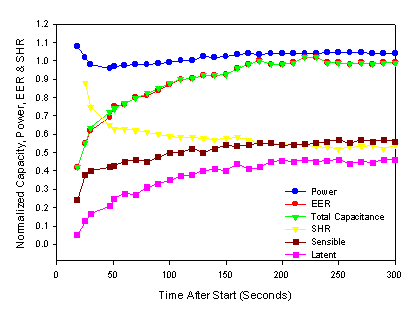
Figure 2. Air-conditioner transient performance during start-up.
The air conditioner's moisture removal rate in fan "auto" did not vary significantly with compressor run-time fraction. An attempt was made to model the moisture removal rate as a function of indoor temperature and humidity and outdoor temperature. The model showed only weak dependence on indoor and outdoor conditions. It was also noticed that the PV house air conditioner's average SHR, as calculated from measured moisture condensate and energy consumption and from rated energy-efficiency ratio, was only 0.80, as opposed to manufacturer's published data of 0.75. Similarly, for the two-speed trailer office air conditioner, the average SHR was measured to be about 0.84 compared to 0.75 in the manufacturer's published data. It is noticed that the average SHR in the field will be lower than expected from steady-state values. This reduction in moisture-removal capacity can be attributed to compressor cycling effects.
The average indoor air conditions maintained under fan "auto" and fan "on" mode in the PV house are shown on a psychometric chart in Figure 3.
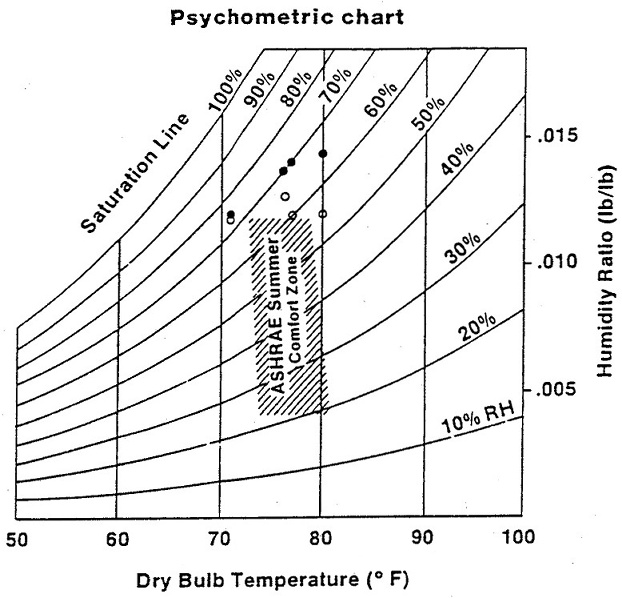
Figure 3. Average indoor air conditions under fan "auto" and fan "on" control strategies.
At a higher temperature setting of about 80 F, the fan "auto" maintained 55% RH whereas the fan "on" maintained 65% RH At this higher temperature setting, the cooling loads are low and the compressor cycles more frequently. The higher humidity may prompt a lower temperature setting for comfort. At lower temperatures the compressor cycling lowered and the gap between the indoor humidities in fan "on" and fan "auto" modes reduced. At 71 F temperature, when the compressor run-time fraction was 80%, the indoor humidity maintained in both modes was nearly same.
There are some other points of observation. First, the indoor conditions maintained were outside the ASHRAE summer thermal comfort zone, which is also plotted on the psychometric chart in Figure 3. It shows that the air conditioner maintained higher humidity even in fan "auto" mode. Therefore, air conditioners with a higher dehumidification fraction or lower SHR are required in warm, humid climates. Second, at low temperature settings, although the absolute humidity was reduced, the indoor relative humidity actually increased slightly. It provided experimental verification of analytical results, which showed that the indoor air relative humidity increases when the temperature set point is reduced (Khattar 1984). The reason is believed to lie in the fact that, at lower temperatures, the ability of air to hold moisture reduces. Therefore, although absolute moisture level reduces, the relative humidity, which is the ratio of actual moisture level to maximum moisture level that the air can hold at that temperature, actually increases.
Transient performance of the PV house air conditioner cycling under fan "on" mode is shown in Figure 4.
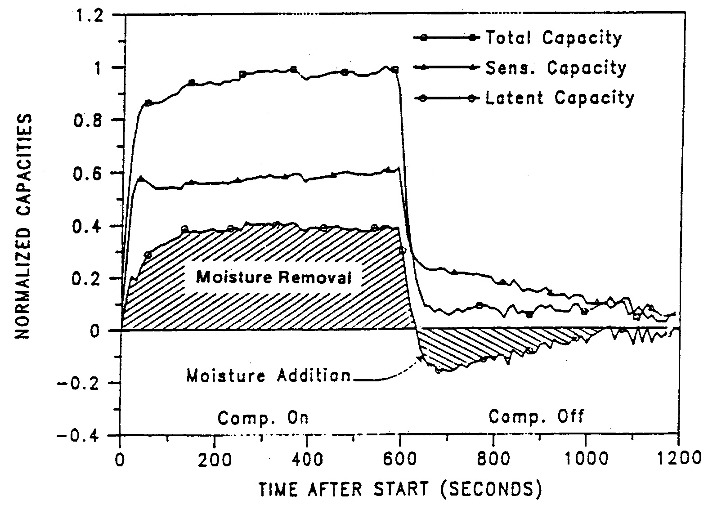
Figure 4. Air-conditioner moisture removal and moisture re-evaporaton under fan "on" operating mode during one compressor cycle (10 minutes "on"/10 minutes "off").
The compressor was cycled on and off every 10 minutes while the fan operated continuously (50% thermostat cycling rate). The normalized total fractional sensible, and fractional latent capacities are plotted against time. The capacities were normalized with respect to steady-state total capacity at the end of the 10-minute cycle. After the unit is turned on at 0 sec, the sensible capacity reached steady state or close to the same value within 30 to 40 seconds. The latent capacity slowly rose to steady-state value in about 150 sec. When the compressor was turned off at 600 sec and allowed the indoor fan to continue, condensed moisture re-evaporated. It is represented as negative latent capacity in the Figure. Moisture evaporation provided positive sensible cooling equal in value to the negative latent cooling. However, some positive net cooling results from thermal mass of the coil. The net cooling would reach zero in some time and eventually become negative because of beat addition from fan.
In this experiment, 19% of the moisture collected during the compressor on-cycle was added back to the space during the compressor off-cycle. The steady-state SHR during the compressor on-cycle was 0.63, while the effective SHR over one complete cycle of compressor on and off was 0.73. The unusually low steady-state SHR value of 0.63 was obtained under humid indoor conditions of 80o F dry-bulb and 68.9 F wet-bulb temperatures, and ambient temperature of 82 F during testing. The indoor temperature was maintained at 80 F and relative humidity was not controlled. A slow rise in fractional sensible capacity and lowering of the fractional latent capacity with the passing of time can be attributed to the fact that the indoor relative humidity began to reduce once the compressor was turned on. During the long-term experiments, however, the moisture removal in the fan "on" mode, as observed from Figure 1 at 50% compressor cycling rate, was nearly 27% less than fan "auto" mode. The higher degradation in moisture removal rate can be attributed to frequent cycling with compressor run-time much lower than 10 minutes during the compressor "on" cycle.
Figures 5 and 6 show the moisture removal histories as measured by the condensate gauge for the two strategies of fan "auto" and fan "on" respectively, for the air conditioner in the PV house. In both cases, the air conditioner was allowed to run continuously for 20 minutes to achieve steady-state operation before any attempt was made to study the effects of the control strategy. The figures also show histographically the times when the compressor and fan were cycled on and off.
At the outset, it must be remarked that even though the figures show some spread of data, the difference in moisture removal trend is clearly established for both strategies. This data spread was traced to the erratic swaying the free hanging drain tube from the air conditioner due to winds, which resulted in the uneven flow of condensate from the drain pan. Also, the effect of the compressor starting or stopping can be observed on the figures, which is marked by a sudden increase in the condensate flow rate. It may be caused due to vibrations associated with starting or stopping of the compressor in the package terminal unit.
The total moisture removed during three cycles (5-min off/10-min on, 5-min off/5-min on, 5-min off/5-min on) for a total period of 35 minutes (from 10 to 45 min on the figure) in the fan "auto" strategy was 2.41 lbs, while in the fan "on" strategy it was only 1.49 lbs. The moisture removal during the fan "on" mode is only about 62% of that of the fan "auto" mode for the same period of compressor cycling. It can be assumed that the rest of the moisture is re-evaporated back into the conditioned space.
It was noticed that when the compressor is turned off, the rate of moisture removal falls more steeply in the fan "on" mode. The draft from the circulating air in the fan "on" mode slows down the condensate drain from the cooling coil surface and re-evaporates the condensed moisture back to the space. In addition, some of the condensed moisture in the pan may also re-evaporate. As expected, the slopes of the ascending curves (i.e., the slopes turning times of increasing moisture removal) do not show considerable differences between fan "on" and fan "auto" modes.
When the compressor comes on, both modes show a lag before the moisture removal begins to increase. However, in the fan "on" mode, the lag time is substantially longer than for the fan "auto" mode: more than 5 minutes versus about 2 minutes. It can be mainly attributed to the fact that the coil is warmer in the fan "on" mode, and it takes longer to cool before beginning of the condensation after re-start of the compressor. Therefore, the coil performs only sensible cooling for a longer time in the fan "on" mode. In the fan "auto" mode, the coils are left cooler and, therefore, the time taken for the coil to reach dew-point temperature is much smaller and condensation of moisture begins earlier. Another reason could be that some of the moisture in the drain pan may be evaporated, lowering its level during fan "on" mode. After the restart of the compressor, it takes time to fill the drain pan before drain overflow may begin. Also, if the cycling time is smaller than the time required for the coil to reach temperature below which moisture may condense, no moisture may be removed. The above two effects can be seen in Figure 5 for the "on" time between 30 and 35 minutes.
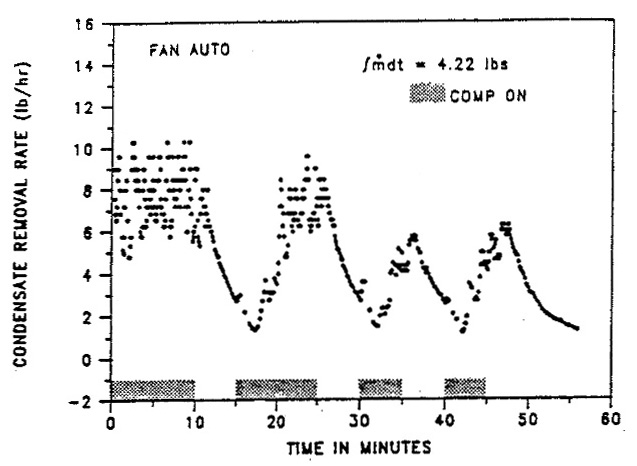
Figure 5. Air-conditioner condensate removal rate vs. compressor run-time in fan "auto" mode.
The effect of this "on" time is felt much later and then only for a short time. As the absolute compressor run time decreases, the moisture removal is adversely affected in the fan "on" mode.
One-on-one comparison of Figures 5 and Figure 6 reveals that the moisture removal in the fan "on" mode is continually lower than the fan "auto" mode for each of the "on" and "off" periods.
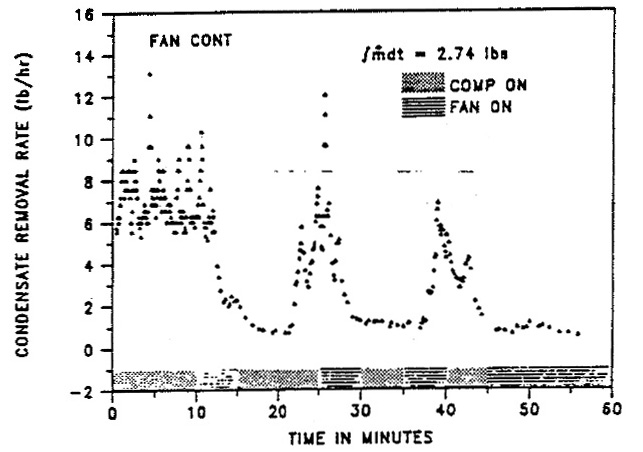
Figure 6. Air-conditioner condensate removal rate vs. compressor run-time in fan "on" mode.
The difference is highest turning the second "on" period, lasting 10 min when the fan "auto" mode removes .78 lbs but the fan "on" mode removes only .34 lbs. Figure 7 shows this one-to-one comparison of the two modes between 10 to 25 min including the second compressor "on" period from 15 to 25 min.
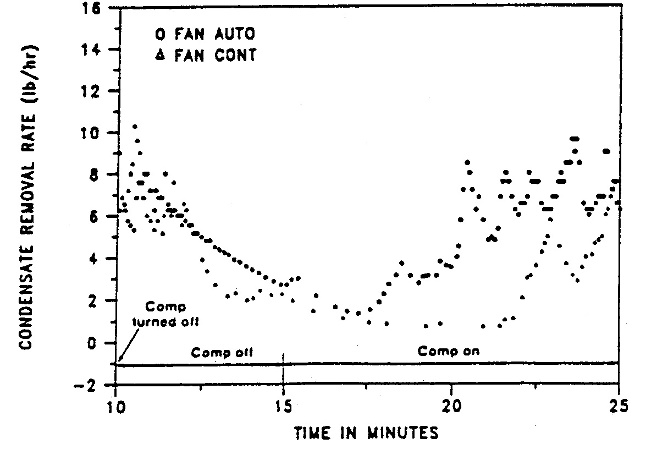
Figure 7. Air-conditioner condensate removal rates in fan "auto" and fan "on" modes.
The moisture removal was 0.4 lbs and 0.34 lbs, respectively,
during the preceding five-minutes "off" period from 10 to
15 min. Also during a 5-min on/5-min off cycle from 30 to 40 min, the
moisture removal was reduced by 44% in the fan "on" mode
compared to the fan "auto" mode. Subsequent moisture-removal
rates are smaller in the "on" periods than in the "off" periods
for both cases. This is due to the fact that the cycling times are
smaller and the lag in moisture removal spills into the "off" periods.
The spillage is more pronounced in the fan "on" mode.
Conclusions
The above discussion and experimental results lead to one major conclusion. For better dehumidification and reduced fluctuations in the indoor humidity, cycle compressor and fan together in unitary air-conditioning systems. To increase air movement for thermal comfort, use local ceiling or paddle fans. Also, the air conditioner dehumidification fraction in the field is lower than what is expected from steady-state tests due to compressor cycling.
It can also be concluded that certain duty-cycling devices, which cycle the compressor off and let the fan operate in order to pick up cooling from the thermal inertia of the cooling coil, would raise indoor humidity. While it is not contested that letting the fan operate will extract the stored cooling in the coil, it will be at the expense of increased indoor humidity. In warm and humid climates, indoor humidities are usually high and duty cyclers may further raise the humidity. High indoor humidities may pose risk to occupant health due to increased chances of mold, mildew, and Fungus growth. It can also prompt lower temperature settings, which will be counterproductive to energy savings. Also, at lower temperature settings, the indoor relative humidity will further increase. Besides, when the compressor turns on again, it would have to do extra work to bring the cooling coil back to a lower temperature.
Further research is recommended to find out other fan control strategies that can maintain better humidity. Fan speed control is one strategy that can improve dehumidification. At lower fan speeds or airflow rates, the air conditioner provides better dehumidification.
Also, modeling of effective air-conditioner SHR, which takes into account
the compressor cycling rates, is recommended. It is the effective SHR,
not the design steady-state SHR, which governs the indoor air-humidity
in air-conditioned buildings.
References
Khattar, M.K., and Swami, M. 1984. "Impact of passive cooling strategies on air conditioner performance in warm, humid climates." Proceedings of the Sixth Annual Technical Conference at the ASME Solar Energy Division, April 9-12, Las Vegas, NV.
Khattar, M.K., 1984. "Residential air conditioning energy calculations." ASHRAE Transactions 1984, Vol. 90, Part 2B.
* Presented at:
ASHRAE Winter Meeting
January 18-21, 1987
New York, NY.
